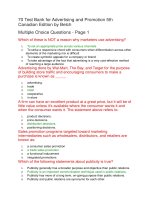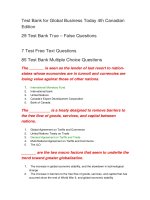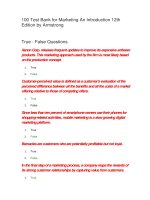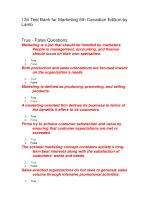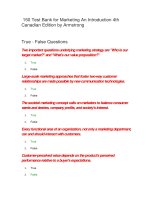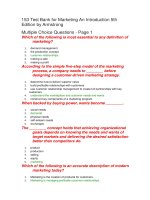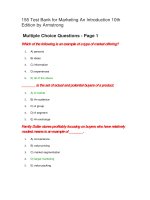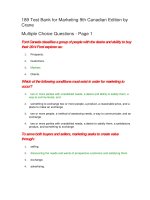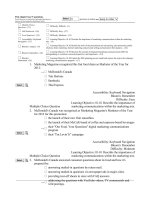150 test bank for marketing an introduction 4th canadian edition by armstrong đề trắc nghiệm marketing
Bạn đang xem bản rút gọn của tài liệu. Xem và tải ngay bản đầy đủ của tài liệu tại đây (217.68 KB, 43 trang )
150 Test Bank for Marketing An Introduction 4th
Canadian Edition by Armstrong
True - False Questions
Two important questions underlying marketing strategy are "Who is our
target market?" and "What's our value proposition?"
1.
True
2.
False
Large-scale marketing approaches that foster two-way customer
relationships are made possible by new communication technologies.
1.
True
2.
False
The societal marketing concept calls on marketers to balance consumer
wants and desires, company profits, and society's interest.
1.
True
2.
False
Every functional area of an organization, not only a marketing department,
can and should interact with customers.
1.
True
2.
False
Customer-perceived value depends on the product's perceived
performance relative to a buyer's expectations.
1.
True
2.
False
Unlike Web 1.0 and 2.0, Web 3.0 is about connecting people with
information.
1.
True
2.
False
The difference between human needs and wants is that needs are not
influenced by marketers.
1.
True
2.
False
Marketing management is interested in serving all customers in every way
to remain competitive in today's markets.
1.
True
2.
False
Selling is managing profitable customer relationships.
1.
True
2.
False
Market offerings are limited to physical products.
1.
True
2.
False
Customer-perceived value is defined as the customer's evaluation of the
perceived difference between all the benefits and all the costs of a
marketing offer relative to those of competing offers.
1.
True
2.
False
Marketers should look beyond the attributes of the products and services
they sell to also create brand experiences for consumers.
1.
True
2.
False
When sellers focus on existing needs and lose sight of underlying
customer wants, they suffer from marketing myopia.
1.
True
2.
False
It is cheaper for a company to acquire new customers than to maintain
relationships with current customers.
1.
True
2.
False
The twofold goal of marketing is to attract new customers by promising
superior value and to keep and grow current customers by delivering
satisfaction.
1.
True
2.
False
Amy's law office has developed a new format and wording for wills. The
staff believes they offer the most in quality, performance, and innovative
features. Her law office is practicing the production concept.
1.
True
2.
False
Product, price, place, and promotion make up the elements of a firm's
marketing mix.
1.
True
2.
False
New communication technologies create challenges as well as
advantages for marketers.
1.
True
2.
False
Delivering superior customer value and customer satisfaction are the two
keys to building lasting customer relationships.
1.
True
2.
False
In its broadest sense, customer relationship management (CRM) is a
customer data management activity.
1.
True
2.
False
Market segmentation is the process of seeking fewer customers and
reduced demand for profit maximization.
1.
True
2.
False
Market offerings can include products, services, information, or
experiences offered to a market to satisfy a need or want.
1.
True
2.
False
A customer-centered organization seeks to maximize customer
satisfaction.
1.
True
2.
False
The production concept and product concept are orientations that can
lead to marketing myopia.
1.
True
2.
False
The major difference between customer-driving marketing and customerdriven marketing is that the customer-driving marketing considers only
existing needs.
1.
True
2.
False
Human needs are shaped by culture and individual personality.
1.
True
2.
False
When backed by buying power, needs become wants.
1.
True
2.
False
Only sellers of products, services, and ideas practice marketing, whereas
buyers do not.
1.
True
2.
False
Consumer-generated marketing, a relatively new phenomenon, has so far
had little impact as a marketing force.
1.
True
2.
False
The selling concept holds that consumers will not buy enough of the
firm's products unless it undertakes a large-scale selling and promotion
effort.
1.
True
2.
False
Mutiple Choice Questions - Page 1
"Build a better mousetrap and the world will beat a path to your door"
reflects the ________ concept.
1.
A) production
2.
B) marketing
3.
C) selling
4.
D) product
5.
E) target marketing
According to the simple five-step model of the marketing process, a
company needs to ________ before designing a customer-driven
marketing strategy.
1.
A) determine how to deliver superior value
2.
B) build profitable relationships with customers
3.
C) use customer relationship management to create full partnerships with key
customers
4.
D) understand the marketplace and customer needs and wants
5.
E) construct key components of a marketing program
The ________ concept holds that achieving organizational goals depends
on knowing the needs and wants of target markets and delivering the
desired satisfaction better than competitors do.
1.
A) product
2.
B) production
3.
C) selling
4.
D) equity
5.
E) marketing
According to the authors of your text, the ________ concept is a "sense
and respond" philosophy rather than a "make and sell" philosophy.
1.
A) product
2.
B) production
3.
C) marketing
4.
D) retailing
5.
E) societal marketing
The ________ steps of the five-step marketing process are about
understanding customers, creating customer value, and building strong
customer relationships.
1.
A) first two
2.
B) first three
3.
C) first four
4.
D) last three
5.
E) last four
Which of the following is the most likely result of a marketing strategy that
attempts to serve all customers?
1.
A) All customers will be delighted.
2.
3.
B) Customer-perceived value will be increased.
C) Customer evangelists will become unpaid salespersons for the service or
product.
4.
D) Few customers will be satisfied.
5.
E) The company will likely need to follow up with a demarketing campaign.
Which of the following reflects the marketing concept philosophy?
1.
A) "We don't have a marketing department, we have a customer department."
2.
B) "We're in the business of making and selling superior products."
3.
C) "We build them so you can buy them."
4.
D) "When it's profits versus customers' needs, profits will always win out."
5.
E) "You won't find a better deal anywhere."
Which customer question is answered by a company's value proposition?
1.
A) "Why should I buy your brand rather than a competitor's?"
2.
B) "How does your brand benefit me and society?"
3.
C) "What are the costs and benefits of your brand?"
4.
5.
D) "What kind of experience will I have with products and services associated with
this brand?"
E) "What are the benefits of being a loyal consumer of your brand?"
Consumer research, product development, communication, distribution,
pricing, and service are all most accurately described as core ________
activities.
1.
A) exchange
2.
B) marketing
3.
C) management
4.
D) production
5.
E) customer relationship management
The product concept says that a company should ________.
1.
A) improve marketing of its best products
2.
B) market only those products with high customer appeal
3.
C) focus on the target market and make products that meet those customers'
demands
4.
D) devote its energy to making continuous product improvements
5.
E) make promoting products the top priority
A firm that uses the selling concept takes a(n) ________ approach.
1.
A) outside-in
2.
B) customer-driven
3.
C) inside-out
4.
D) marketing concept
5.
E) customer service
________ is the act of obtaining a desired object from someone by
offering something in return.
1.
A) A value proposition
2.
B) Exchange
3.
C) Bribery
4.
D) Value
5.
E) Donation
The ________ concept calls for aggressive selling and promotion effort.
1.
A) marketing
2.
B) production
3.
C) product
4.
D) selling
5.
E) societal marketing
When backed by buying power, wants become ________.
1.
A) social needs
2.
B) demands
3.
C) physical needs
4.
D) self-esteem needs
5.
E) exchanges
The art and science of choosing target markets and building profitable
relationships with them is called ________.
1.
A) marketing management
2.
B) positioning
3.
C) segmentation
4.
D) selling
5.
E) societal marketing
Which of the following marketing management concepts is most closely
aligned with the philosophy of continuous product improvement and the
belief that customers will choose products that offer high quality,
performance, and innovative features?
1.
A) product
2.
B) production
3.
C) customer
4.
D) marketing
5.
E) promotion
Which of the following is an accurate description of modern marketing
today?
1.
A) Marketing is the creation of products for customers.
2.
B) Marketing is managing profitable customer relationships.
3.
C) Selling and advertising are synonymous with marketing.
4.
D) Marketing involves satisfying producers' needs first.
5.
E) Marketing is used by for-profit organizations only.
________ refers to sellers that pay more attention to their own products
than to the benefits and experiences produced by these products.
1.
A) Selling myopia
2.
B) Marketing management
3.
C) Value proposition
4.
D) Marketing myopia
5.
E) The product concept
Which of the following is an example of a type of market offering?
1.
A) products, information
2.
B) products, ideas
3.
C) products, information
4.
D) products, experiences
5.
E) products, ideas, information, experiences
________ is defined as a social and managerial process by which
individuals and organizations obtain what they need and want through
creating and exchanging value with others.
1.
A) Selling
2.
B) Advertising
3.
C) Bartering
4.
D) Marketing
5.
E) Negotiating
According to management guru Peter Drucker, "The aim of marketing is to
________."
1.
A) create customer demands
2.
B) identify customer demands
3.
C) make selling unnecessary
4.
D) set realistic customer expectations
5.
E) sell products
Selecting which segments of a population of customers to serve is called
________.
1.
A) market segmentation
2.
B) positioning
3.
C) customization
4.
D) target marketing
5.
E) choosing a value proposition
Which of the following marketing management orientations focuses
primarily on improving efficiencies along the supply chain?
1.
A) production concept
2.
B) product concept
3.
C) selling concept
4.
D) marketing concept
5.
E) societal marketing concept
If this is the only marketing management concept adopted, manufacturers
can develop to marketing myopia?
1.
A) customer-driven marketing
2.
B) customer-driving marketing
3.
C) societal marketing
4.
D) selling
5.
E) product
________ is the set of actual and potential buyers of a product.
1.
A) A market
2.
B) An audience
3.
C) A group
4.
D) A segment
5.
E) An exchange
Family Dollar stores profitably focusing on buyers who have relatively
modest means is an example of ________.
1.
A) convenience
2.
B) value pricing
3.
C) market segmentation
4.
D) target marketing
5.
E) value packing
When marketers set low expectations for a market offering, they are most
likely to run the risk of which of the following?
1.
A) disappointing loyal buyers
2.
B) decreasing buyers satisfaction
3.
C) failing to attract enough buyers
4.
D) failing to understand their buyers' needs
5.
E) incorrectly identifying a target market
In addition to attracting new customers and creating transactions, the
goal of marketing is to ________ customers and grow the company's
business.
1.
A) encourage
2.
B) entertain
3.
C) retain
4.
D) recognize
5.
E) educate
________ is the set of benefits a company promises to deliver to its
consumers to satisfy their needs.
1.
A) A money-back guarantee
2.
B) Low pricing
3.
C) Good customer service
4.
D) A value proposition
5.
E) An attribute
________ are human needs as shaped by individual personality and
culture.
1.
A) Deprivations
2.
B) Wants
3.
C) Demands
4.
D) Values
5.
E) Exchanges
94 Free Test Bank for Marketing An Introduction 4th
Canadian Edition by Armstrong Mutiple Choice
Questions - Page 2
The set of marketing tools a firm uses to implement its marketing strategy
is called the ________.
1.
A) promotion mix
2.
B) product mix
3.
C) marketing mix
4.
D) TQM
5.
E) marketing effort
Customer-driven marketing is most likely to work well when ________ and
when customers ________.
1.
A) a clear need exists; are difficult to identify
2.
B) customers do not know what they want; have limited budgets
3.
C) there are few competitors; are concerned about their long-run welfare
4.
D) a clear need exists; know what they want
5.
E) a want exists; cannot afford it
The final step in the marketing process is ________.
1.
A) capturing value from customers
2.
B) creating customer loyalty
3.
C) creating customer lifetime value
4.
D) understanding the marketplace
5.
E) designing a customer-driven marketing strategy
Which of the following is an example of consumer-generated marketing?
1.
A) Toyota's presence in online communities
2.
3.
B) Nike's Nike Plus running Web site
C) H. J. Heinz's use of brand-related consumer videos posted on video-sharing
Web sites
4.
D) Neiman Marcus's InCircle Rewards program for its best customers
5.
E) The Lexus Covenant aimed at creating customer delight
Of the following, which is perhaps the most important concept of modern
marketing?
1.
A) customer relationship management
2.
B) e-mail advertising
3.
C) mass marketing
4.
D) properly trained sales people
5.
E) low prices
FedEx offers its customers fast and reliable package delivery. When
FedEx customers weigh these aforementioned benefits against the
monetary and psychic costs of using the service, they are acting upon
________.
1.
A) loyalty
2.
B) relationship marketing
3.
C) customer-perceived value
4.
D) social relationships
5.
E) a societal marketing campaign
The societal marketing concept seeks to establish a balance between
consumer short-run wants and consumer ________.
1.
A) short-run costs and profits
2.
B) short-run ethics
3.
C) long-run welfare
4.
D) immediate health
5.
E) value propositions
Which of the following has contributed to the deeper, more interactive
nature of today's customer relationships?
1.
A) e-mail
2.
B) television advertising
3.
C) Newspaper ads
4.
D) radio advertising
5.
E) outdoor ads
Which of the following strategies would a company most likely use to
increase customer satisfaction?
1.
A) decreasing variety of services offered
2.
B) lengthening the supply chain
3.
C) lowering prices or increasing its services
4.
D) "firing" unprofitable customers
5.
E) limiting experiences with a brand
It is most accurate to say that a customer will buy from the company that
offers the highest ________.
1.
A) value for the dollar
2.
B) customer perceived value
3.
C) level of customer satisfaction
4.
D) company image
5.
E) concern for society's interests
Stew Leonard, owner/operator of supermarkets, reacts adversely to losing
a single customer sale. He feels that this amounts to losing the entire
stream of future purchases that a customer is likely to make if he or she
remains in the area. This is an illustration of ________.
1.
A) share of customer
2.
B) market share
3.
C) profitability
4.
D) customer lifetime value
5.
E) market share maintenance
The marketing world is embracing ________ because consumers can
wield greater power and control in the marketplace through
communication technologies.
1.
A) partner relationship management
2.
B) supply chain management
3.
C) customer-managed relationships
4.
D) market segmentation
5.
E) target marketing
Which of the following best explains why consumers have greater power
and control in today's marketplace?
1.
A) The production concept and competition have lowered prices.
2.
B) Implementation of the product concept has resulted in continually improving
products.
3.
C) Customer-driving marketing creates products and services that meet
customers' future needs.
4.
D) More companies are implementing societal marketing and weighing long-run
costs and benefits.
5.
E) Through new communication technologies, customers have more access to
information and more methods of sharing their opinions with other customers.
Through ________, many companies today are strengthening their
connections to all partners, from providers of raw materials and
components to final buyers who purchase final products.
1.
A) supply chain management
2.
B) direct marketing
3.
C) partnership relationship marketing
4.
D) customized marketing
5.
E) deviated marketing
The three areas of consideration that should be balanced in the societal
marketing concept are consumer wants, society's interests, and
________.
1.
A) human welfare
2.
B) want satisfaction
3.
C) company profits
4.
D) short-run wants
5.
E) long-term needs
Frequent flyer programs offered by airlines are an example of a ________.
1.
A) frequency marketing program
2.
B) basic customer relationship
3.
C) club marketing program
4.
D) consumer-generated marketing program
5.
E) structural benefit provided for top customers
The ________ concept holds that firms must strive to deliver value to
customers in a way that maintains or improves both the consumer's and
society's well being.
1.
A) marketing
2.
B) selling
3.
C) product
4.
D) societal marketing
5.
E) equity
In today's world, marketing should be done by ________ in an
organization.
1.
A) marketing
2.
B) marketing, sales, and customer-support
3.
C) sales and technology
4.
D) management
5.
E) everyone
To capture the full essence of customer relationship management, which
of the following should a marketing manager take into consideration?
1.
A) owning customers for life
2.
B) owning customers for life, capturing a customer's lifetime value
3.
C) owning customers for life, capturing a customer's lifetime value, building overall
customer equity
4.
D) owning customers for life, building overall customer equity, creating a sense of
community surrounding a brand
5.
E) owning customers for life, capturing a customer's lifetime value, building overall
customer equity, creating a sense of community surrounding a brand
Partner relationship management focuses on working with ________ to
bring more value to customers.
1.
A) partners inside and outside of the company
2.
B) competitors
3.
C) consumers
4.
D) interest groups
5.
E) all of the above
Building and maintaining profitable value-laden relationships with
customers of a company is called ________.
1.
A) customer lifetime value
2.
B) customer perceived value
3.
C) customer relationship management
4.
D) database marketing
5.
E) societal marketing
When customers don't know what they want or don't even know what's
possible, the most effective strategy is ________ marketing.
1.
A) customer-driven
2.
B) customer-driving
3.
C) societal
4.
D) production
5.
E) product
Which of the following is determined by a customer's personal evaluation
of the benefits and costs of a market offering relative to those of
competing offers?
1.
A) customer-perceived value
2.
B) customer satisfaction
3.
C) customer-perceived performance
4.
D) customer relationship management
5.
E) market segmentation
Greater consumer control means that companies must rely more on
marketing by ________ than by ________.
1.
A) interruption; involvement
2.
B) attraction; intrusion
3.
C) socialization; information
4.
D) producing; selling
5.
E) inspiration; competition
When the economy tightens, customer loyalty and customer retention
become ________ for marketers.
1.
A) even more important
2.
B) less important
3.
C) impossible
4.
D) long-term but not short-term goals
5.
E) short-term but not long-term goals
Which of the following is the term for customers who make repeat
purchases and tell others about their positive experiences with a product
or service?
1.
A) satisfied customers
2.
B) customer evangelists
3.
C) butterflies
4.
D) full partners
5.
E) social customers
94 Free Test Bank for Marketing An Introduction 4th
Canadian Edition by Armstrong Mutiple Choice
Questions - Page 3
The ultimate aim of customer relationship management is to produce
________.
1.
A) high customer equity
2.
B) high current market share
3.
C) steady sales volume
4.
D) a reliable database
5.
E) satisfied customers
Which of the following is currently the fastest-growing form of marketing?
1.
A) consumer-generated marketing
2.
B) online marketing
3.
C) mass media marketing
4.
D) social marketing
5.
E) word-of-mouth marketing
You are an assistant marketing director for a firm in a market with many
low-margin customers. What type of relationship would it be most
profitable for you to develop with these customers?
1.
A) full partnerships
2.
B) basic relationships
3.
C) club programs
4.
D) selective relationships
5.
E) community relationships
Greg Williams now has the buying power to purchase the computer
system he has wanted for the last six months. Greg's want now has
become a ________.
1.
A) need
2.
B) necessity
3.
C) demand
4.
D) satisfier
5.
E) transaction
The Niketown running club that organizes twice weekly evening runs for
Nike customers is an example of a ________.
1.
A) frequency marketing program
2.
B) basic customer relationship
3.
C) club marketing program
4.
D) consumer-generated marketing program
5.
E) structural benefit provided for top customers
When an airline goes after a "share of travel" from its customers, it is
attempting to increase ________.
1.
A) its value proposition
2.
B) share of customer
3.
C) target markets
4.
D) customer variety
5.
E) customer ownership
Railroads were once operated based on the thinking that users wanted
trains rather than transportation, overlooking the challenge of other
modes of transportation. This reflects the ________.
1.
A) product concept
2.
B) production concept
3.
C) selling concept
4.
D) marketing concept
5.
E) societal marketing concept
Jolene's firm believes that consumers will not buy enough of its products
unless the firm undertakes a large-scale selling and promotion effort.
Jolene's firm is practicing the ________.
1.
A) production concept
2.
B) marketing concept
3.
C) selling concept
4.
D) relationship concept
5.
E) social advertising campaign
The social-responsibility and environmental movements are expected to
________ in the future.
1.
A) demand more from companies
2.
B) demand less from companies
3.
C) move away from sustainable marketing
4.
D) move toward partner relationship management
5.
E) move away from using social networking
Marie Ortiz enjoys her work at Futuristic Designs, Inc. Her organization
understands and anticipates customer needs even better than customers
themselves do and creates products and services to meet current and
future wants and demands. Marie's firm practices ________ marketing.
1.
A) customer-driven
2.
B) customer-driving
3.
C) societal
4.
D) donor
5.
E) none of the above
